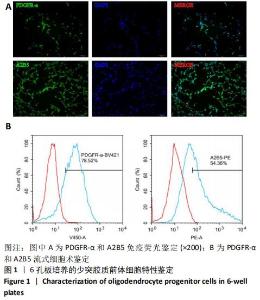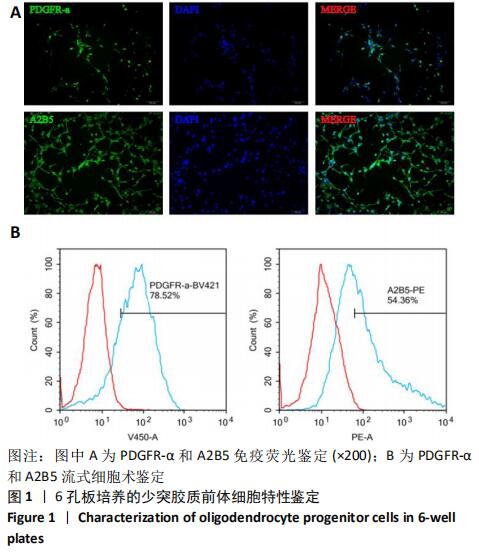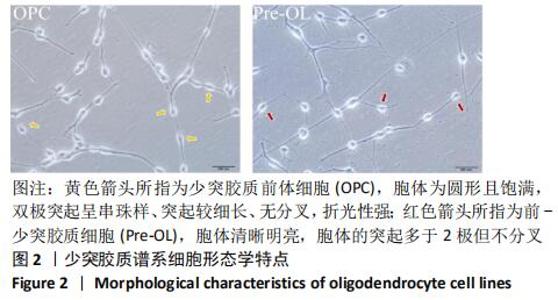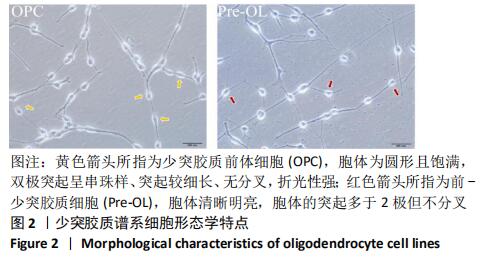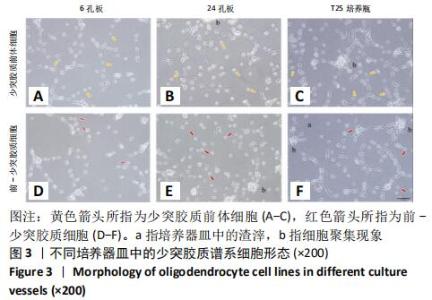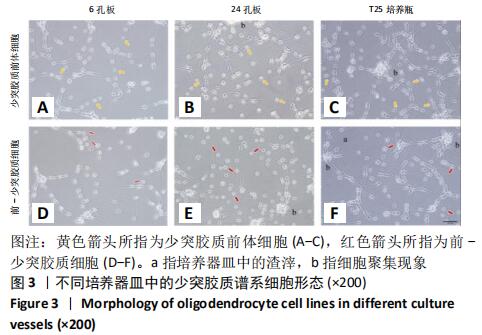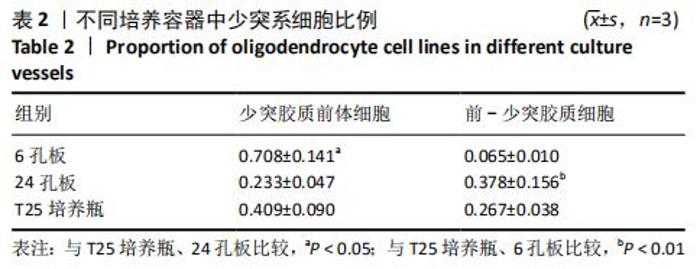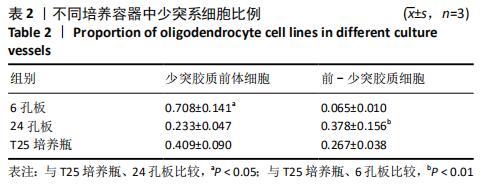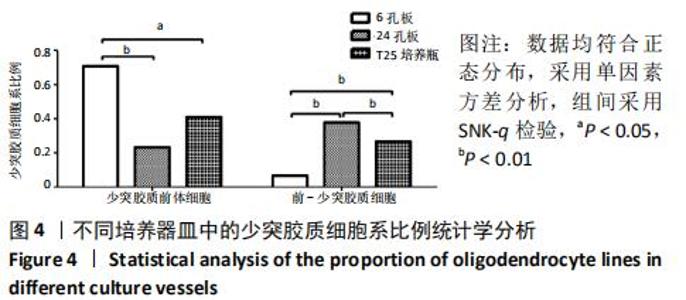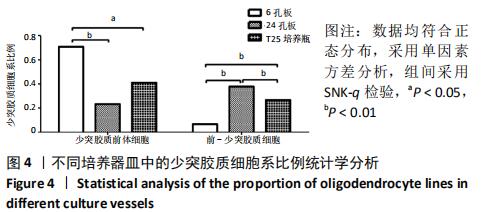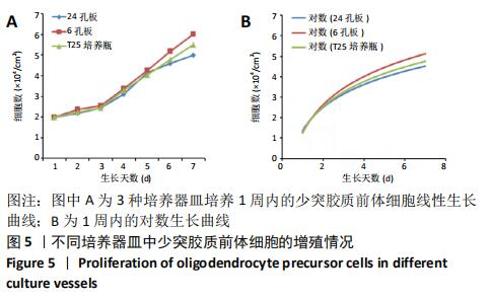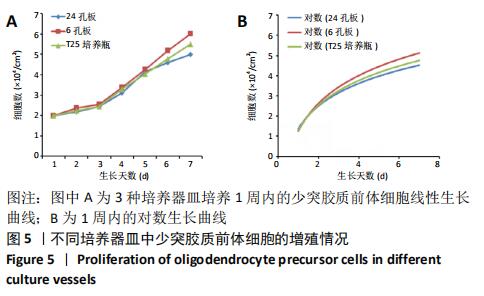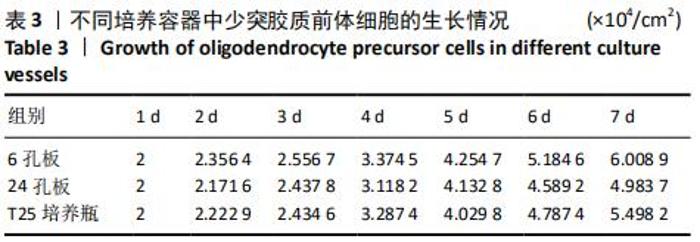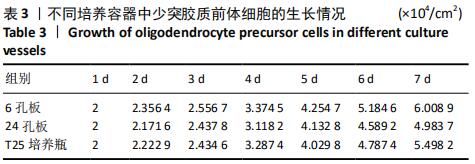Chinese Journal of Tissue Engineering Research ›› 2021, Vol. 25 ›› Issue (1): 44-49.doi: 10.3969/j.issn.2095-4344.2139
Previous Articles Next Articles
Proportion and morphological characteristics of human oligodendrocyte precursor cells in different cell culture vessels
- 1 Department of Cell Biology and Neurobiology, Xuzhou Medical University, Xuzhou 221004, Jiangsu Province, China; 2 Department of Pedistrics, The Sixth Medical Center of Chinese PLA General Hospital, Beijing 100048, China
-
Received:2020-01-02Revised:2020-01-07Accepted:2020-02-26Online:2021-01-08Published:2020-10-28 -
Contact:Yao Ruiqin, MD, Professor, Department of Cell Biology and Neurobiology, Xuzhou Medical University, Xuzhou 221004, Jiangsu Province, China -
About author:Ye Dou, Master candidate, Department of Cell Biology and Neurobiology, Xuzhou Medical University, Xuzhou 221004, Jiangsu Province, China; Department of Pedistrics, The Sixth Medical Center of Chinese PLA General Hospital, Beijing 100048, China -
Supported by:the National Key Research and Development Program for Stem Cell and Translational Research, No. 2017YFA0104200
CLC Number:
Cite this article
Ye Dou, , Ma Xuexia , Guan Qian, , Luan Zuo , Yang Yinxiang , Wang Zhaoyan , Wang Qian , He Ying , Yao Ruiqin. Proportion and morphological characteristics of human oligodendrocyte precursor cells in different cell culture vessels[J]. Chinese Journal of Tissue Engineering Research, 2021, 25(1): 44-49.
share this article
Add to citation manager EndNote|Reference Manager|ProCite|BibTeX|RefWorks
| [1] VAN TILBORG E, DE THEIJE CGM, VAN HAL M, et al. Origin and dynamics of oligodendrocytes in the developing brain: Implications for perinatal white matter injury. Glia. 2018;66(2): 221-238. [2] BACK SA. White matter injury in the preterm infant: pathology and mechanisms. Acta Neuropathol. 2017;134(3):331-349. [3] BARATEIRO A, BRITES D, FERNANDES A. Oligodendrocyte Development and Myelination in Neurodevelopment: Molecular Mechanisms in Health and Disease. Curr Pharm Des. 2016;22(6):656-679. [4] SALMASO N, JABLONSKA B, SCAFIDI J, et al. Neurobiology of premature brain injury. Nat Neurosci. 2014;17(3):341-346. [5] ALIZADEH A, DYCK SM, KARIMI-ABDOLREZAEE S. Myelin damage and repair in pathologic CNS: challenges and prospects. Front Mol Neurosci. 2015;8:35. [6] DIETZ KC, POLANCO JJ, POL SU, et al. Targeting human oligodendrocyte progenitors for myelin repair. Exp Neurol. 2016;283(Pt B):489-500. [7] WANG S, BATES J, LI X, et al. Human iPSC-derived oligodendrocyte progenitor cells can myelinate and rescue a mouse model of congenital hypomyelination. Cell Stem Cell. 2013;12(2):252-264. [8] YAMASHITA T, MIYAMOTO Y, BANDO Y, et al. Differentiation of oligodendrocyte progenitor cells from dissociated monolayer and feeder-free cultured pluripotent stem cells. PLoS One. 2017;12(2): e0171947. [9] MCLANE LE, BOURNE JN, EVANGELOU AV, et al. Loss of Tuberous Sclerosis Complex1 in Adult Oligodendrocyte Progenitor Cells Enhances Axon Remyelination and Increases Myelin Thickness after a Focal Demyelination. J Neurosci. 2017;37(31):7534-7546. [10] WANG C, LUAN Z, YANG Y, et al. High purity of human oligodendrocyte progenitor cells obtained from neural stem cells: suitable for clinical application. J Neurosci Methods. 2015;240:61-66. [11] BUNGE RP. Glial cells and the central myelin sheath. Physiol Rev. 1968; 48(1):197-251. [12] FILLEY CM, FIELDS RD. White matter and cognition: making the connection. J Neurophysiol. 2016;116(5):2093-2104. [13] LESCA G, VANIER MT, CREISSON E, et al. X-linked adrenoleukodystrophy in a female proband: clinical presentation, biological diagnosis and family consequences. Arch Pediatr. 2005;12(8):1237-1240. [14] Van der Knaap MS, Bugiani M. Leukodystrophies: a proposed classification system based on pathological changes and pathogenetic mechanisms. Acta Neuropathol. 2017;134(3): 351-382. [15] KEOUGH MB, YONG VW. Remyelination therapy for multiple sclerosis. Neurotherapeutics. 2013;10(1):44-54. [16] NISHIYAMA A, KOMITOVA M, SUZUKI R, et al. Polydendrocytes (NG2 cells): multifunctional cells with lineage plasticity. Nat Rev Neurosci. 2009;10(1):9-22. [17] PAYNE SC, BARTLETT CA, SAVIGNI DL, et al. Early proliferation does not prevent the loss of oligodendrocyte progenitor cells during the chronic phase of secondary degeneration in a CNS white matter tract. PLoS One. 2013;8(6):e65710. [18] ESPINOSA-JEFFREY A, BLANCHI B, BIANCOTTI JC, et al. Efficient Generation of Viral and Integration-Free Human Induced Pluripotent Stem Cell-Derived Oligodendrocytes. Curr Protoc Stem Cell Biol. 2016; 39(1):2D.18.1-2D.18.28. [19] HU BY, DU ZW, ZHANG SC. Differentiation of human oligodendrocytes from pluripotent stem cells. Nat Protoc. 2009;4(11):1614-1622. [20] SANTOS AK, VIEIRA MS, VASCONCELLOS R, et al. Decoding cell signalling and regulation of oligodendrocyte differentiation. Semin Cell Dev Biol. 2019;95:54-73. [21] NEWVILLE J, JANTZIE LL, CUNNINGHAM LA.Embracing oligodendrocyte diversity in the context of perinatal injury. Neural Regen Res. 2017; 12(10):1575-1585. [22] BARATEIRO A, FERNANDES A. Temporal oligodendrocyte lineage progression: in vitro models of proliferation, differentiation and myelination. Biochim Biophys Acta. 2014;1843(9):1917-1929. [23] HUGHES EG, KANG SH, FUKAYA M, et al. Oligodendrocyte progenitors balance growth with self-repulsion to achieve homeostasis in the adult brain. Nat Neurosci. 2013;16(6): 668-676. [24] BERGLES DE, RICHARDSON WD. Oligodendrocyte Development and Plasticity. Cold Spring Harb Perspect Biol. 2015;8(2):a020453. [25] YEUNG MS, ZDUNEK S, BERGMANN O, et al. Dynamics of oligodendrocyte generation and myelination in the human brain. Cell. 2014;159(4):766-774. [26] EL WALY B, MACCHI M, CAYRE M, et al. Oligodendrogenesis in the normal and pathological central nervous system. Front Neurosci. 2014; 8:145. [27] NAVE KA, WERNER HB. Myelination of the nervous system: mechanisms and functions. Annu Rev Cell Dev Biol. 2014;30: 503-533. [28] BULLER B, CHOPP M, UENO Y, et al. Regulation of serum response factor by miRNA-200 and miRNA-9 modulates oligodendrocyte progenitor cell differentiation. Glia. 2012; 60(12):1906-1914. [29] MCMURRAN CE, KODALI S, YOUNG A, et al. Clinical implications of myelin regeneration in the central nervous system. Expert Rev Neurother. 2018;18(2):111-123. [30] CZEPIEL M, BODDEKE E, COPRAY S. Human oligodendrocytes in remyelination research. Glia. 2015;63(4): 513-530. [31] OSORIO MJ, ROWITCH DH, TESAR P, et al. Concise Review: Stem Cell-Based Treatment of Pelizaeus- Merzbacher Disease. Stem Cells. 2017; 35(2):311-315. [32] DOUVARAS P, RUSIELEWICZ T, KIM KH, et al. Epigenetic Modulation of Human Induced Pluripotent Stem Cell Differentiation to Oligodendrocytes. Int J Mol Sci. 2016;17(4). pii: E614. [33] THIRUVALLUVAN A, CZEPIEL M, KAP YA, et al. Survival and Functionality of Human Induced Pluripotent Stem Cell-Derived Oligodendrocytes in a Nonhuman Primate Model for Multiple Sclerosis. Stem Cells Transl Med. 2016;5(11): 1550-1561. [34] PIAO J, MAJOR T, AUYEUNG G, et al. Human embryonic stem cell-derived oligodendrocyte progenitors remyelinate the brain and rescue behavioral deficits following radiation. Cell Stem Cell. 2015;16(2): 198-210. [35] MARTEYN A, SARRAZIN N, YAN J, et al. Modulation of the Innate Immune Response by Human Neural Precursors Prevails over Oligodendrocyte Progenitor Remyelination to Rescue a Severe Model of Pelizaeus-Merzbacher Disease. Stem Cells. 2016;34(4):984-996. [36] MAGNANI D, CHANDRAN S, WYLLIE DJA, et al. In Vitro Generation and Electrophysiological Characterization of OPCs and Oligodendrocytes from Human Pluripotent Stem Cells. Methods Mol Biol. 2019;1936: 65-77. [37] PRASAD A, TEH DBL, BLASIAK A, et al. Static Magnetic Field Stimulation Enhances Oligodendrocyte Differentiation and Secretion of Neurotrophic Factors. Sci Rep. 2017;7(1): 6743. [38] WANG C, ZHANG CJ, MARTIN BN, et al. IL-17 induced NOTCH1 activation in oligodendrocyte progenitor cells enhances proliferation and inflammatory gene expression. Nat Commun. 2017;8:15508. [39] LIM CT, ZHOU EH, QUEK ST. Mechanical models for living cells--a review. J Biomech. 2006;39(2):195-216. [40] JEN CJ, JHIANG SJ, CHEN HI. Invited review: effects of flow on vascular endothelial intracellular calcium signaling of rat aortas ex vivo. J Appl Physiol (1985). 2000;89(4):1657-1662, 1656. [41] BACHRACH NM, VALHMU WB, STAZZONE E, et al. Changes in proteoglycan synthesis of chondrocytes in articular cartilage are associated with the time-dependent changes in their mechanical environment. J Biomech. 1995;28(12):1561-1569. [42] LIU SQ. Influence of tensile strain on smooth muscle cell orientation in rat blood vessels. J Biomech Eng. 1998;120(3): 313-320. [43] ZHANG C, ZHOU L, ZHANG F, et al. Mechanical remodeling of normally sized mammalian cells under a gravity vector. FASEB J. 2017;31(2): 802-813. [44] 吕东媛,周吕文,龙勉.干细胞的生物力学研究[J].力学进展, 2017, 47(1): 534-585. [45] WANG CY, DENEEN B, TZENG SF. BRCA1/BRCA2- containing complex subunit 3 controls oligodendrocyte differentiation by dynamically regulating lysine 63-linked ubiquitination. Glia. 2019;67(9):1775-1792. [46] KAINDL J, MEISER I, MAJER J, et al. Zooming in on Cryopreservation of hiPSCs and Neural Derivatives: A Dual-Center Study Using Adherent Vitrification. Stem Cells Transl Med. 2019;8(3):247-259. |
| [1] | Zhu Xuefen, Huang Cheng, Ding Jian, Dai Yongping, Liu Yuanbing, Le Lixiang, Wang Liangliang, Yang Jiandong. Mechanism of bone marrow mesenchymal stem cells differentiation into functional neurons induced by glial cell line derived neurotrophic factor [J]. Chinese Journal of Tissue Engineering Research, 2021, 25(7): 1019-1025. |
| [2] | Wang Zhengdong, Huang Na, Chen Jingxian, Zheng Zuobing, Hu Xinyu, Li Mei, Su Xiao, Su Xuesen, Yan Nan. Inhibitory effects of sodium butyrate on microglial activation and expression of inflammatory factors induced by fluorosis [J]. Chinese Journal of Tissue Engineering Research, 2021, 25(7): 1075-1080. |
| [3] | Jiao Hui, Zhang Yining, Song Yuqing, Lin Yu, Wang Xiuli. Advances in research and application of breast cancer organoids [J]. Chinese Journal of Tissue Engineering Research, 2021, 25(7): 1122-1128. |
| [4] | Huang Dengcheng, Wang Zhike, Cao Xuewei. Intravenous, topical tranexamic acid alone or their combination in total knee arthroplasty: a meta-analysis of randomized controlled trials [J]. Chinese Journal of Tissue Engineering Research, 2021, 25(6): 948-956. |
| [5] | Zhan Fangbiao, Cheng Jun, Zou Xinsen, Long Jie, Xie Lizhong, Deng Qianrong. Intraoperative intravenous application of tranexamic acid reduces perioperative bleeding in multilevel posterior spinal surgery: a meta-analysis [J]. Chinese Journal of Tissue Engineering Research, 2021, 25(6): 977-984. |
| [6] | Yang Xin, Jin Zhe, Feng Xu, Lu Bing. The current situation of knowledge and attitudes towards organ, eye tissue, body donation of residents in Shenyang [J]. Chinese Journal of Tissue Engineering Research, 2021, 25(5): 779-784. |
| [7] | Liu Bo, Chen Xianghe, Yang Kang, Yu Huilin, Lu Pengcheng. Mechanism of DNA methylation in exercise intervention for osteoporosis [J]. Chinese Journal of Tissue Engineering Research, 2021, 25(5): 791-797. |
| [8] | Zhang Guomei, Zhu Jun, Hu Yang, Jiao Hongwei. Stress of three-dimensional finite element models of E-MAX porcelain inlay [J]. Chinese Journal of Tissue Engineering Research, 2021, 25(4): 537-541. |
| [9] | Cheng Jun, Tan Jun, Zhao Yun, Cheng Fangdong, Shi Guojia. Effect of thrombin concentration on the prevention of postoperative cerebrospinal leakage by fibrin glue [J]. Chinese Journal of Tissue Engineering Research, 2021, 25(4): 570-575. |
| [10] | Li Li, Ma Li. Immobilization of lactase on magnetic chitosan microspheres and its effect on enzymatic properties [J]. Chinese Journal of Tissue Engineering Research, 2021, 25(4): 576-581. |
| [11] | Liu Fei, Cui Yutao, Liu He. Advantages and problems of local antibiotic delivery system in the treatment of osteomyelitis [J]. Chinese Journal of Tissue Engineering Research, 2021, 25(4): 614-620. |
| [12] | Ye Haimin, Ding Linghua, Kong Weihao, Huang Zutai, Xiong Long. Role and mechanism of hierarchical microchanneled bone scaffolds in promoting osteogenesis and angiogenesis [J]. Chinese Journal of Tissue Engineering Research, 2021, 25(4): 621-625. |
| [13] | Yu Langbo, Qing Mingsong, Zhao Chuntao, Peng Jiachen. Hot issues in clinical application of dynamic contrast-enhanced magnetic resonance imaging in orthopedics [J]. Chinese Journal of Tissue Engineering Research, 2021, 25(3): 449-455. |
| [14] | Li Yanle, Yue Xiaohua, Wang Pei, Nie Weizhi, Zhang Junwei, Tan Yonghai, Jiang Hongjiang. Intramedullary nail fixation versus plate fixation in the treatment of displaced midshaft clavicular fractures in adults: a meta-analysis [J]. Chinese Journal of Tissue Engineering Research, 2021, 25(3): 471-476. |
| [15] | Wang Xinting, Xu Dandi, Zhang Junxia, Su Hailong Wang Qi. Stability of load-bearing cross barrier of different arch structures [J]. Chinese Journal of Tissue Engineering Research, 2021, 25(24): 3838-3843. |
| Viewed | ||||||
|
Full text |
|
|||||
|
Abstract |
|
|||||
